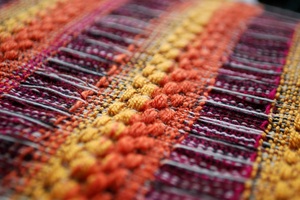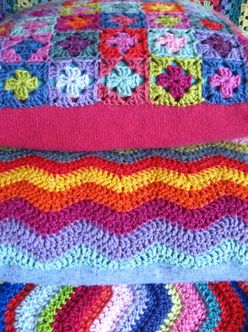Pottery

Pottery is the material from which the potteryware is made,of which major types include earthenware, stoneware and porcelain. The place where such wares are made is also called a pottery (plural "potteries"). Pottery also refers to the art or craft of the potter or the manufacture of pottery.
Pottery is made by forming a clay body into objects of a required shape and heating them to high temperatures in a
Pottery is made by forming a clay body into objects of a required shape and heating them to high temperatures in a
Basket Weaving

Basket weaving (also basketry, basket making, or basketmaking) is the process ofweaving unspun vegetable fibres into a basket or other similar form. People and artists who weave baskets are called basketmakers and basket weavers.
Basketry is made from a variety of fibrous or pliable materials•anything that will bend and form a shape. Examples include pine straw, stems, animal hair, hide, grasses, thread, andwood.
Basketry is made from a variety of fibrous or pliable materials•anything that will bend and form a shape. Examples include pine straw, stems, animal hair, hide, grasses, thread, andwood.
Weaving

Weaving is a method of fabric production in which two distinct sets of yarns or threads are interlaced at right angles to form a fabric or cloth. The other methods are knitting, lace making, felting, and braiding or plaiting. The longitudinal threads are called the warp and the lateral threads are the weft or filling. (Weft or woof is an old English word meaning "that which is woven". The method in which these threads are inter woven affects the characteristics of the cloth.
Cloth is usually woven on a loom, a device that holds the warp threads in place while filling threads are woven through them. A fabric band which meets this definition of cloth (warp threads with a weft thread winding between) can also be made using other methods, including tablet weaving, back-strap, or other techniques without looms.
The way the warp and filling threads interlace with each other is called the weave. The majority of woven products are created with one of three basic weaves: plain weave, satin weave, or twill. Woven cloth can be plain (in one colour or a simple pattern), or can be woven in decorative or artistic designs.
Cloth is usually woven on a loom, a device that holds the warp threads in place while filling threads are woven through them. A fabric band which meets this definition of cloth (warp threads with a weft thread winding between) can also be made using other methods, including tablet weaving, back-strap, or other techniques without looms.
The way the warp and filling threads interlace with each other is called the weave. The majority of woven products are created with one of three basic weaves: plain weave, satin weave, or twill. Woven cloth can be plain (in one colour or a simple pattern), or can be woven in decorative or artistic designs.
Tatting

Tatting is a technique for handcrafting a particularly durable lace constructed by a series of knots and loops.Tatting can be used to make lace edging as well asdoilies, collars, and other decorative pieces. The lace is formed by a pattern of rings and chains formed from a series of cow hitch, or half-hitch knots, called double stitches , over a core thread. Gaps can be left between the stitches to form picots, which are used for practical construction as well as decorative effect.
Tatting dates to the early 19th century. The term for tatting in most European languages is derived from French frivolité, which refers to the purely decorative nature of the textiles produced by this technique. The technique was developed to imitate point lace.
Tatting dates to the early 19th century. The term for tatting in most European languages is derived from French frivolité, which refers to the purely decorative nature of the textiles produced by this technique. The technique was developed to imitate point lace.
Macramé

Macramé or macrame is a form of textile-making using knotting rather than weaving orknitting. Its primary knots are the square knot and forms of "hitching": full hitch and doublehalf hitches. It was long crafted by sailors, especially in elaborate or ornamental knotting forms, to decorate anything from knife handles to bottles to parts of ships. Materials used in macramé include cords made of cotton twine, linen, hemp, jute, leather oryarn. Cords are identified by construction, such as a 3-ply cord, made of 3 lengths of fibre twisted together.
Crochet

Crochet is a process of creating fabric fromyarn, thread, or other material strands using a crochet hook.The word is derived from the Frenchword "crochet", meaning hook. Hooks can be made of materials such as metals, woods or plastic and are commercially manufactured as well as produced by artisans. Crocheting, like knitting, consists of pulling loops through other loops, but additionally incorporates wrapping the working material around the hook one or more times.
Crochet differs from knitting in that only one stitch is active at one time, stitches made with the same diameter of yarn are comparably taller, and a single crochet hook is used instead of twoknitting needles. Additionally, crochet has its own system of symbols to represent stitch types.
Crochet differs from knitting in that only one stitch is active at one time, stitches made with the same diameter of yarn are comparably taller, and a single crochet hook is used instead of twoknitting needles. Additionally, crochet has its own system of symbols to represent stitch types.
Tapestry

Tapestry is a form of textile art, traditionally woven on a vertical loom. However, it can also be woven on a floor loom as well. It is composed of two sets of interlaced threads, those running parallel to the length (called the warp) and those parallel to the width (called the weft); the warp threads are set up under tension on a loom, and the weft thread is passed back and forth across part or all of the warps. Tapestry is weft-faced weaving, in which all thewarp threads are hidden in the completed work, unlike cloth weaving where both the warp and the weft threads may be visible. In tapestry weaving, weft yarns are typically discontinuous; the artisan interlaces each coloured weft back and forth in its own small pattern area. It is a plain weft-faced weave having weft threads of different colours worked over portions of the warp to form the design.
Most weavers use a naturally based warp thread such as linen or cotton. The weft threads are usually wool or cotton, but may include silk, gold, silver, or other alternatives.
Most weavers use a naturally based warp thread such as linen or cotton. The weft threads are usually wool or cotton, but may include silk, gold, silver, or other alternatives.
Mosaic

Mosaic is the art of creating images with an assemblage of small pieces of colored glass, stone, or other materials. It may be a technique of decorative art, an aspect of interior decoration, or of cultural and spiritual significance as in a cathedral. Small pieces, normally roughly quadratic, of stone or glass of different colors, known as tesserae, (diminutivetessellae), are used to create a pattern or picture.
Collage

Collage (From the French: coller, to glue) is a technique of an art production, primarily used in the visual arts, where the artwork is made from an assemblage of different forms, thus creating a new whole.
A collage may sometimes include newspaper clippings, ribbons, bits of colored or handmade papers, portions of other artwork or texts, photographsand other found objects, glued to a piece of paper or canvas. The origins of collage can be traced back hundreds of years, but this technique made a dramatic reappearance in the early 20th century as an art form of novelty.™
Techniques of collage were first used at the time of the invention of paper in China, around 200 BC. The use of collage, however, wasn't used by many people until the 10th century in Japan, when calligraphers began to apply glued paper, using texts on surfaces, when writing their poems.
A collage may sometimes include newspaper clippings, ribbons, bits of colored or handmade papers, portions of other artwork or texts, photographsand other found objects, glued to a piece of paper or canvas. The origins of collage can be traced back hundreds of years, but this technique made a dramatic reappearance in the early 20th century as an art form of novelty.™
Techniques of collage were first used at the time of the invention of paper in China, around 200 BC. The use of collage, however, wasn't used by many people until the 10th century in Japan, when calligraphers began to apply glued paper, using texts on surfaces, when writing their poems.
Calligraphy

Calligraphy (from Greek kallos "beauty" +graphẽ "writing") is a type of visual art related to writing. It is the design and execution of lettering with a broad tip instrument or brush in one stroke (as opposed to built up lettering, in which the letters are drawn.) . A contemporary definition of calligraphic practice is "the art of giving form to signs in an expressive, harmonious and skillful manner" . The story of writing is one of aesthetic evolution framed within the technical skills, transmission speed and material limitations of a person, time and place. A style of writing is described as a script, hand or alphabet.
Calligraphy continues to flourish in the forms of wedding and event invitations, font design/typography, original hand-lettered logo design, religious art, announcements/graphic design/commissioned calligraphic art, cut stone inscriptions and memorial documents. It is also used for props and moving images for film and television, testimonials, birth and death certificates, maps, and other works involving writing. Some of the finest works of modern calligraphy are charters and letters patent issued by monarchs and officers of state in various countries.
http://en.wikipedia.org/wiki/Handicraft
Calligraphy continues to flourish in the forms of wedding and event invitations, font design/typography, original hand-lettered logo design, religious art, announcements/graphic design/commissioned calligraphic art, cut stone inscriptions and memorial documents. It is also used for props and moving images for film and television, testimonials, birth and death certificates, maps, and other works involving writing. Some of the finest works of modern calligraphy are charters and letters patent issued by monarchs and officers of state in various countries.
http://en.wikipedia.org/wiki/Handicraft
